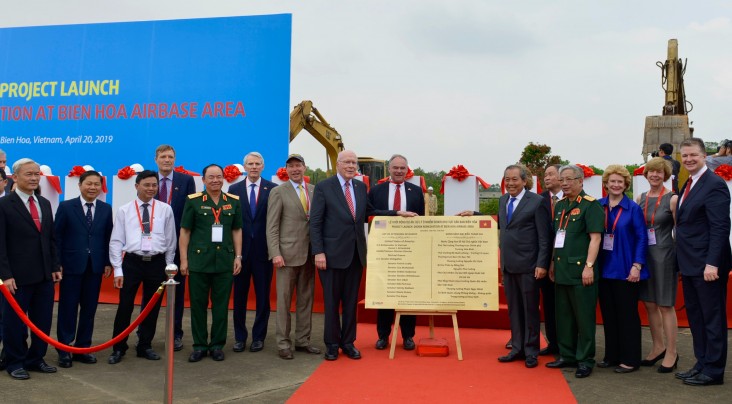Vietnam
- History
- Our Work
- Newsroom
- Partner with us!
- Foreign Assistance Data
- Lower Mekong Initiative (LMI)
- Careers
- Implementing Partner Opportunities
- Transforming Lives
- Reports and Publications
- Tools, Guidelines, and Templates for USAID Partners
Speeches Shim

After completion of the Environmental Remediation of Dioxin Contamination at Danang Airport in 2018, at the request of the Government of Vietnam (GVN), the U.S. Government agreed to cooperate on dioxin remediation at Bien Hoa Airbase Area, the primary Agent Orange storage and handling site during the U.S.-Vietnam War and the largest remaining dioxin hotspot in Vietnam.
ASSESSING THE CHALLENGE
Working in partnership with the GVN, USAID completed an assessment of dioxin contamination at Bien Hoa in 2016. Apart from determining the nature and extent of dioxin contamination, the assessment also developed potential remediation alternatives, including both containment and treatment options, to reduce the risk of dioxin exposure on and around the Airbase. The assessment identified almost 500,000 cubic meters of dioxin contaminated soil and sediment in need of remediation – almost four times the volume in Danang.
PROJECT INITIATION
In 2018, USAID signed agreements with Vietnam’s Ministry of National Defense for an initial 5-year, $183 million contribution to the Dioxin Remediation at Bien Hoa Airbase Area Project. Following formal GVN project approval, USAID and MND launched the Project on April 20, 2019. Deputy Prime Minister Truong Hoa Binh, a nine U.S. Senate delegation, led by Senator Patrick Leahy, and other high-level officials from the two governments joined the launch to highlight the project’s importance for deepening the U.S.-Vietnam Comprehensive Partnership.
In September 2019, USAID and GVN partners initiated a one-year project master planning process. The final plan currently under review by GVN leadership estimates a ten-year implementation period of excavation and treatment activities costing up to $450 million. USAID contributions to the project will target activities in the plan’s initial, five-year Phase 1. With the additional $20 million obligated in November 2020, USAID funding to date will be $113,650,000 of the total estimated USAID contribution of $183 million.
EARLY FIELD WORK
Throughout 2020, USAID and MND collaborated on collecting and analyzing additional site data on topography, baseline environmental conditions, and soil contamination to guide detailed excavation and treatment design work. Guided by these analyses, USAID has scheduled initial excavation work to begin in December 2020 and continuing over the next six-month dry season. Initial excavation work targets areas where contamination poses heightened health and environmental risks because of its location proximity to Airbase and community activities. At the same time, USAID will complete construction of a long-term storage facility for excavated soils with low levels of dioxin contamination and short-term storage for highly contaminated soils that will be treated in subsequent years.
Projects
Bien Hoa Dioxin Remediation: cooperate on efforts, including assessment and implementation, to remediate dioxin contamination at Bien Hoa Airbase Area, the primary Agent Orange storage and handling site during the U.S.-Vietnam War and the largest remaining dioxin hotspot in Vietnam. 2020-2030, $183 million.
Danang Dioxin Remediation: jointly with Vietnamese Ministry of National Defense, implement the environmental remediation, or cleanup, of the Danang Airport due to high dioxin concentrations in soil and sediment remaining from the U.S.-Vietnam War. Successfully completed and returned 32.4 hectares of remediated land in November 2018. 2012-2018, $110 million.
Information provided on this website includes:
Videos
- Environmental Remediation of Dioxin Contamination at Danang Airport Project
- VTV4 Report: U.S., Vietnam Cooperate on Agent Orange/Dioxin Remediation
- Public Service Announcement: Environmental Remediation Project at Danang Airport
- In-Pile Thermal Desorption (IPTD) Animation
Photo Albums
Dioxin Remediation at Bien Hoa Airbase Area
Environmental Remediation of Dioxin Contamination at Danang Airport
- Dioxin Contamination Treatment at Danang Airport Project Completion Ceremony (November 2018)
- Start of Second Phase of Dioxin Contamination Treatment at Danang Airport (October 2016)
- Successful First Phase of Treatment of Dioxin Contamination at Danang Airport (May 2016)
- Progress of the Project in 2015 and the first quarter of 2016
- General Martin Dempsey visits the Danang dioxin remediation site (August 2014)
- Ceremony to Turn on the Treatment System at Danang Airport (April 2014)
- Progress on the Environmental Remediation of Dioxin Contamination at Danang Airport Project (March 2014)
- Community Outreach Session on the Environmental Remediation of Dioxin Contamination at Danang Airport Project (March 2014)
- Progress on the Environmental Remediation of Dioxin Contamination at Danang Airport Project (December 2013)
- Progress on the Environmental Remediation of Dioxin Contamination at Danang Airport Project (July 2013)
- Progress on the Environmental Remediation of Dioxin Contamination at Danang Airport Project (June 2013)
- Progress on the Environmental Remediation of Dioxin Contamination at Danang Airport Project (April 2013)
- Media Tour of Environmental Remediation of Dioxin Contamination at Danang Airport Project (April 2013)
- Site Preparation for Environmental Remediation of Dioxin Contamination at Danang Airport (January 2013)
- Environmental Remediation of Dioxin Contamination at Danang Airport Project Launch (August 2012)


Comment
Make a general inquiry or suggest an improvement.